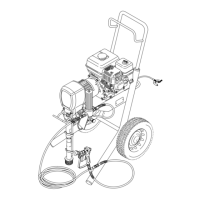4
308-327
WARNINGS
High
Pressure Spray Can Cause Serious Injury
. For Professional Use Only.
Observe All W
arnings. Read and understand all instruction manuals before operating equipment.
FLUID
INJECTION HAZARD
General
Safety
This
equipment generates very high fluid pressure. Spray from
the
gun, leaks or ruptured components can inject fluid through
your
skin and into your body
, causing extremely serious
bodily
injury,
including the need for
amputation. Also, fluid injected or
splashed into the eyes or on the skin can cause serious dam-
age.
NEVER
point the spray gun at any one or at any part of the body
.
NEVER
put your hand or fingers over the spray
tip. NEVER try
to “blow back” paint; this is NOT an air spray system.
ALWAYS have the tip guard in place on the spray gun when
spraying.
ALWAYS
follow the
Pressure Relief Procedure
, below
, before
cleaning or removing the spray tip or servicing any system
equipment.
NEVER
try to stop or deflect leaks with your hand or body
.
Be
sure equipment safety devices are operating properly before
each
use.
Medical Alert--Airless Spray W
ounds
If any fluid appears to penetrate your skin, get EMERGENCY
MEDICAL CARE AT ONCE. DO NOT TREAT AS A SIMPLE
CUT.
T
ell the doctor exactly what fluid was injected.
Note
to Physician:
Injection in the skin is a traumatic injury
.
It
is
important to treat the injury surgically as soon as possible.
Do
not delay treatment to research toxicity
.
T
oxicity is a concern
with some exotic coatings injected directly into the blood
stream. Consultation with a plastic surgeon or reconstructive
hand
surgeon may be advisable.
Spray Gun Safety Devices
Be sure all gun safety devices are operating properly before
each
use. Do not remove or modify any part of the gun; this can
cause
a malfunction and result in serious bodily injury
.
Safety Latch
Whenever you stop spraying, even for a moment, always set
the
gun safety latch in
the closed or “safe” position, making the
gun
inoperative. Failure to set the safety latch can result in acci
-
dental
triggering of the gun.
Diffuser
The gun diffuser breaks up spray and reduces the risk of fluid
injection
when the tip is not installed. Check dif
fuser operation
regularly. Follow the PRESSURE RELIEF PROCEDURE
, be
-
low, then remove the spray tip. Aim the gun into a metal pail,
holding
the gun
firmly to the pail. Using the lowest possible pres
-
sure, trigger the gun. If the fluid emitted
is not
diffused into an
irregular
stream, replace the dif
fuser immediately
.
T
ip Guard
ALWAYS have the tip guard in place on the spray gun while
spraying. The tip guard alerts you to the fluid injection hazard
and
helps reduce, but does not prevent, the
risk of accidentally
placing
your
fingers or any part of your body close to the spray
tip.
Trigger
Guard
Always
have the trigger guard in place on the gun when spray
-
ing to reduce the risk of accidentally triggering the gun if it is
dropped
or bumped.
Spray T
ip Safety
Use extreme caution when cleaning or changing spray tips. If
the
spray tip clogs while spraying, engage the gun safety latch
immediately. ALWAYS follow the PRESSURE RELIEF PRO-
CEDURE,
below, and then remove the spray tip to clean it.
NEVER
wipe of
f build-up around the spray tip until the
pressure
is
fully relieved and the gun safety is engaged.
PRESSURE
RELIEF
PROCEDURE
To
reduce the risk of serious bodily injury
, including fluid injec
-
tion,
splashing fluid or solvent in the eyes or on the skin, or
injury
from moving parts or electric shock, always follow this proce-
dure
whenever you shut
of
f the sprayer
, when checking or serv
-
icing
any part of the spray system, when installing, cleaning or
changing
spray tips, and whenever you stop spraying.
1.
Engage the gun safety latch.
2. T
urn the engine ON/OFF switch to OFF
.
3.
Flip the pressure control switch to OFF
.
4. Disengage
the gun safety latch. Hold a
metal part of the gun
firmly to the side of a grounded metal pail, and trigger the
gun
to relieve pressure.
5.
Engage the gun safety latch.
6. Open the pressure drain valve. Leave the valve open until
you are ready to spray again.
7.
Disconnect the spark plug cable.
If
you suspect that the spray tip or hose
is completely clogged,
or that pressure has not been fully relieved after following the
steps
above,
VER
Y SLOWL
Y loosen
the tip guard retaining nut
or
hose end coupling to relieve pressure gradually
, then loosen
completely.
Now clear the tip or hose.
1,5
23 4
6
0139
GASOLINE
ENGINE HAZARD
NEVER
fill the fuel tank while the engine is running or hot. Fuel
spilled
on a hot surface can ignite and cause a fire.
ALWAYS
pour fuel in slowly to avoid spilling. Also read
FIRE OR
EXPLOSION HAZARD
, above, and
FUELING
on page 1
1.
NEVER
operate the engine in a closed building unless the en
-
gine exhaust is piped outside. The exhaust contains carbon
monoxide, a poisonous, odorless and invisible gas which can
cause
serious illness and even death of inhaled.

